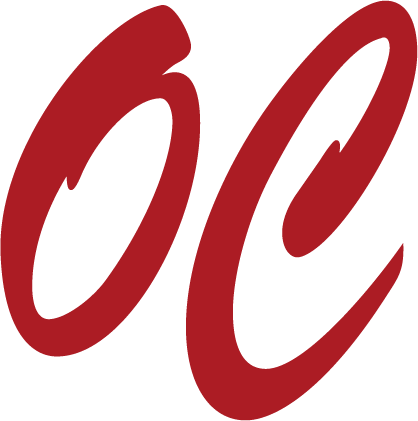Pusher – The return of the world's most influential climbing hold company.
With its series of groundbreaking shape-sets and iconic holds like the Boss, Jabba and the Tri-Cobble, Pusher helped transform indoor climbing into the dynamic sport we know today. So when Clark Shelk closed Pusher in 2014 because he was unable to make "huge financial investments into the company and make big ethical compromises," many climbers felt the decision signaled the end of a very creative and influential period in climbing. Sure, other companies also made great holds, but few had captured and conveyed the creative energy of their local climbing scene as effectively in their products and brand.
So in 2017, when Jared Roth announced that he was re-launching Pusher, many climbers were cautiously optimistic that the brand would not only once again produce many of the classic shapes, but also expand the line with new holds.
We caught up with Roth and talked about the third ascent of the Mandala, the amazing documentary work of Mike Call and the frenetic Salt Lake City climbing scene that defined Pusher and influenced so many climbers.
So in 2017, when Jared Roth announced that he was re-launching Pusher, many climbers were cautiously optimistic that the brand would not only once again produce many of the classic shapes, but also expand the line with new holds.
We caught up with Roth and talked about the third ascent of the Mandala, the amazing documentary work of Mike Call and the frenetic Salt Lake City climbing scene that defined Pusher and influenced so many climbers.
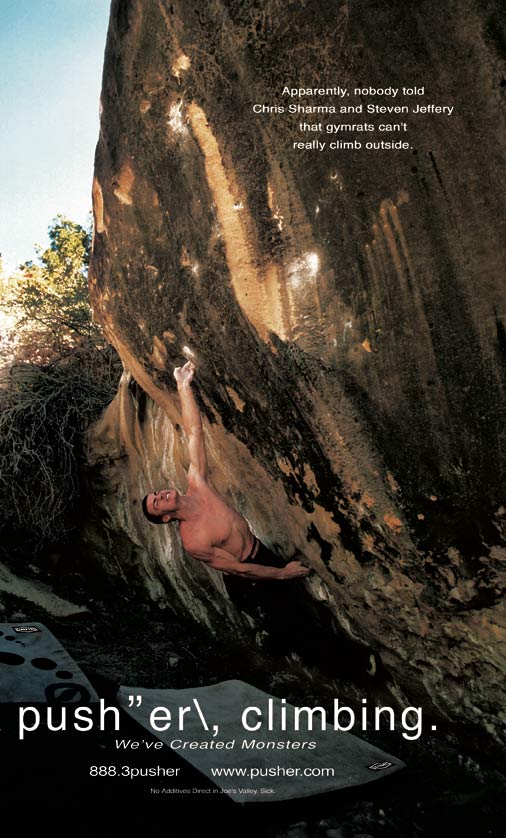
Steven Jeffery climbing No Additives Direct. (Photo: Boone Speed)
Congratulations on taking the helm and re-launching Pusher. Do you feel any pressure knowing that you are now running one of the most important and influential climbing hold companies to come out of North America?
Pusher: Thanks! Yes, I do feel pressure to make sure I do the brand justice. I have gotten such a response from people that it is a bit overwhelming. I knew what I was getting into though, and decided if I let this opportunity pass I would probably regret it for the rest of my life. I can live with the pressure; it’s regret I have a problem with.
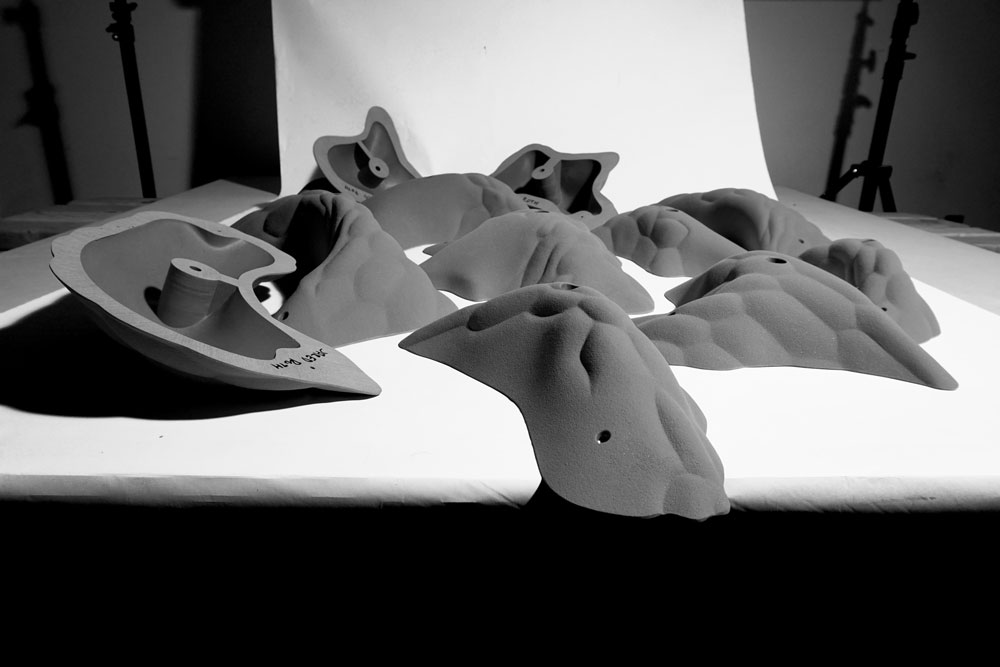
The new Pusher Font holds.
Can you tell us a little bit about yourself and why you think you’re the right person to relaunch this revolutionary brand?
Pusher: I started climbing at the old Wasatch Front Rock Gym in Salt Lake in the spring of 1996. I was 14 years old. The old Front was a reincarnation of the Body Shop. The Body Shop was the first gym in Salt Lake and was started by Dave Bell who also founded Pusher. So I grew up surrounded by these guys and started climbing at the gym that was made to test Pusher holds.
After a few years of climbing (mostly in the gym), I started to venture outside and quickly started climbing up the grade ladder. My senior year in high school I was on the 1999 USA Youth Climbing Team. Jason Campbell helped me train for the World Cups that fall, and shortly after I returned from Europe, I climbed my first 5.14a. The summer of 2000 I got the second ascent of Boone Speed’s I Scream 5.14c, in Hell, and became one of the first handful of Americans to have climbed the grade.
That fall I took a trip to Bishop with my friend Dave Graham to try a new problem Chris Sharma had put up. He ended up getting the second and I got the third ascent of The Mandala. I did a lot of hard problems, but I never felt as compelled as others to constantly prove how hard I could climb. So when I look back at my tick list, it doesn’t seem too impressive.
After a few years of climbing (mostly in the gym), I started to venture outside and quickly started climbing up the grade ladder. My senior year in high school I was on the 1999 USA Youth Climbing Team. Jason Campbell helped me train for the World Cups that fall, and shortly after I returned from Europe, I climbed my first 5.14a. The summer of 2000 I got the second ascent of Boone Speed’s I Scream 5.14c, in Hell, and became one of the first handful of Americans to have climbed the grade.
That fall I took a trip to Bishop with my friend Dave Graham to try a new problem Chris Sharma had put up. He ended up getting the second and I got the third ascent of The Mandala. I did a lot of hard problems, but I never felt as compelled as others to constantly prove how hard I could climb. So when I look back at my tick list, it doesn’t seem too impressive.
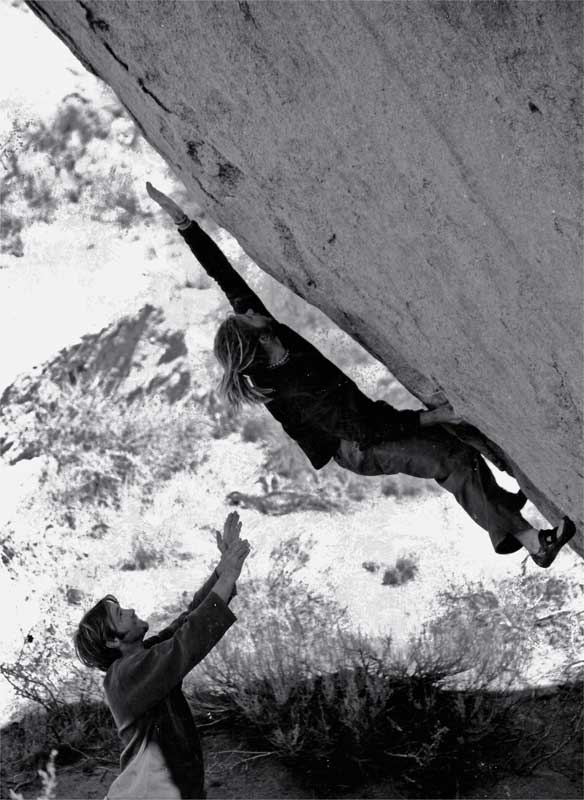
Jared Roth bagging the third ascent of The Mandala.
The most impressive line I did in my mind was the FA of a problem I named Rastaman Vibration. I didn’t rate it but it has one of the hardest moves I have ever done outside on it. It was a line just to the left of Jason Kehl’s Evilution on the Grandpa Peabody. There were rumours that maybe John Bachar had done the top of it but I don’t know how he could reach up there to start without doing the hard move. I started from standing on the ground. It’s a 65-foot tall boulder. I rapped off the top and tried to clean it up a bit and make sure there were holds, but I never top rope rehearsed it. I never rated it, but because of the first move, it was pretty much a 5.14d first ascent free solo with a sketchy slab move up top too. Many years later people eventually succeeded at doing the sit start and now it's known as Lucid Dreaming. This basically adds one hard move into my problem. I was excited watching the video of Alex Megos sending it and listening to how he describes the problem. It’s just perfect. No tricks. It was happy to hear Alex comparing my boulder problem to an iconic route like Action Direct.
Anyway, I’ve been around a bit and climbed some stuff. I have been climbing for 21 years and a lot of that has been in a gym. I’ve been sponsored by a lot of companies before and know how this climbing industry thing works. I planned to start a new hold company inspired by Pusher, but first I thought I'd ask Clark whether he was going to do anything with Pusher ever again. We ended up working a deal out. I felt the need to snatch up Pusher and make sure it stays true to its roots. There are enough big corporate climbing companies out there now and I just want to make sure some history gets saved so people remember where we came from. Pusher’s success won’t be based on how much money I have in my bank account, but rather by how many lives I can touch. As you get older, you realize that climbing was actually more about who you were with and what feelings you shared, rather than how hard you climbed or what problems you sent. I want to be that old climber that gives these kids the same passion for life that I got from my older friends who came before me. I guess in a way it just makes my ego feel better.
Anyway, I’ve been around a bit and climbed some stuff. I have been climbing for 21 years and a lot of that has been in a gym. I’ve been sponsored by a lot of companies before and know how this climbing industry thing works. I planned to start a new hold company inspired by Pusher, but first I thought I'd ask Clark whether he was going to do anything with Pusher ever again. We ended up working a deal out. I felt the need to snatch up Pusher and make sure it stays true to its roots. There are enough big corporate climbing companies out there now and I just want to make sure some history gets saved so people remember where we came from. Pusher’s success won’t be based on how much money I have in my bank account, but rather by how many lives I can touch. As you get older, you realize that climbing was actually more about who you were with and what feelings you shared, rather than how hard you climbed or what problems you sent. I want to be that old climber that gives these kids the same passion for life that I got from my older friends who came before me. I guess in a way it just makes my ego feel better.
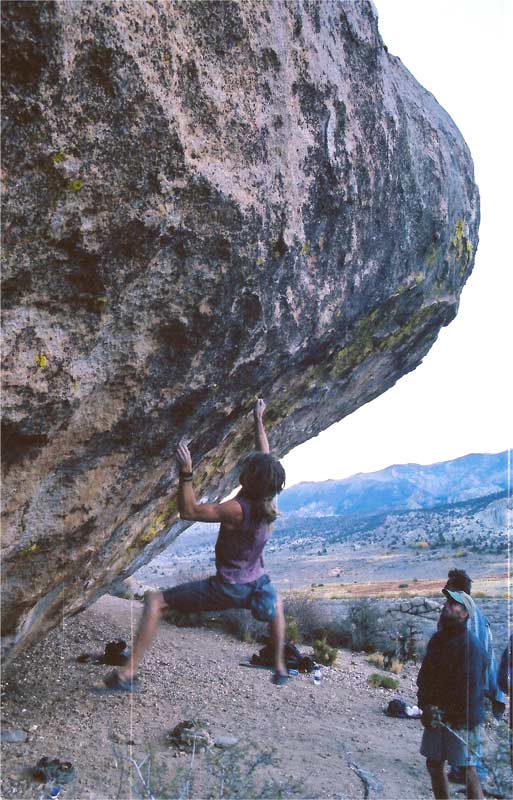
Jared Roth making the non-top-rope-rehearsed first ascent of the 65-foot tall boulder problem, Rastaman Vibration 5.14d.
Some readers may not remember Pusher. Care to offer some insight into the company’s colourful history?
Pusher: Pusher, in my mind, is the greatest hold company that has ever existed. It was started and owned by real climbers that loved climbing. It is going to be impossible for me to completely convey the significance of Pusher here. They just were way ahead of their time. They were a major part in molding the indoor climbing scene into what it has become. Before Facebook and Instagram, there was a guy named Mike Call running around with a video camera. He caught the actual moment when an American finally put up the hardest route in our country. Necessary Evil was bolted by Boone Speed who worked at Pusher. He showed his project to a young Chris Sharma who sent it in 8 days of work. Mike’s videos captured Chris’s ability to push way beyond what people were thinking was possible and made it so we could watch this in our living rooms. I would never have climbed so hard if it wasn’t for watching Chris. He was amazing to watch and time after time did the impossible, usually with his feet off. The Pusher guys captured these moments forever. They were so much more than a climbing company. They were the heart and soul of the Salt Lake climbing scene. Climbing would not be what it was or is without them. I just want to make sure people never forget that.
Pusher also gathered attention from others which eventually led to it being purchased and combined with the most famous pad company ever, Cordless. Also onboard was Ben Moon's company S7. These guys also bought the best training gym in the US, The Wasatch Front Rock Gym. Famous climbers would come from around the world to camp in the parking lot and train. This giant conglomeration of super-companies was great, but it also led to their downfall. In my opinion, the fallout from this was the greatest destruction of a climbing scene that has probably ever happened. Climbing is bigger now, but Salt Lake has never been the same.
Pusher also gathered attention from others which eventually led to it being purchased and combined with the most famous pad company ever, Cordless. Also onboard was Ben Moon's company S7. These guys also bought the best training gym in the US, The Wasatch Front Rock Gym. Famous climbers would come from around the world to camp in the parking lot and train. This giant conglomeration of super-companies was great, but it also led to their downfall. In my opinion, the fallout from this was the greatest destruction of a climbing scene that has probably ever happened. Climbing is bigger now, but Salt Lake has never been the same.
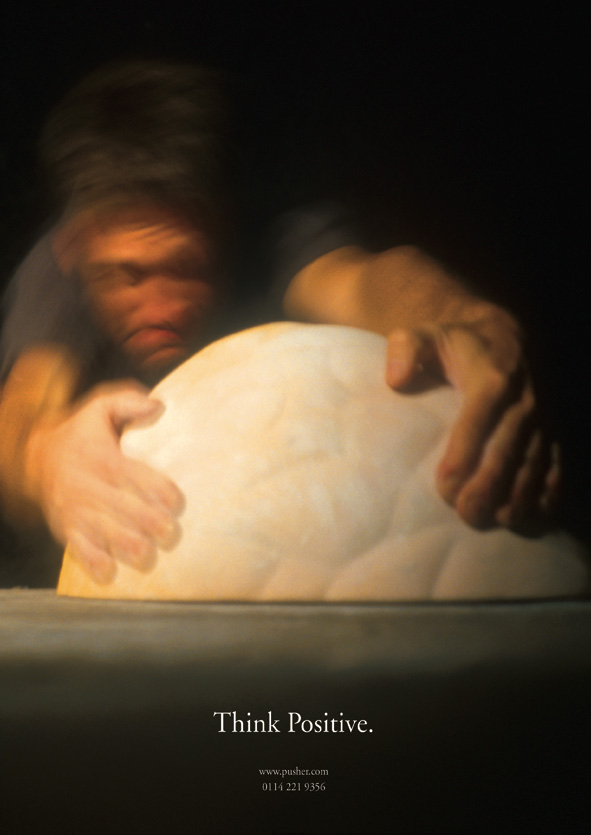
Mike Call battling with the iconic Pusher Boss. (Photo: Boone Speed)
What are your short-term plans with Pusher?
Pusher: Get the foundation set up. There is a lot to do to start a company. It’s great because everyone already knows Pusher, but I just need people to understand that it is going to take me many months to get the basics set up. I’m really excited at the interest people are showing though and I really appreciate it.
And for the long-term?
Pusher: Make cool holds. Make some cool shirts, stickers. Stuff like that. Maybe some crash pads down the line. I’d like to see Pusher make some new videos. I just want to see it grow back into what it was and then I want to add my chapter to it. I want to see it remain owned by me and not get bought up by some giant corporation like a lot of other companies have been lately. It seems like as they get bigger, they start to only care about making money for shareholders; they care more about numbers than the people that make those numbers. I know that’s part of life, and good for them, but I think there will always be love for the homegrown company that stays close to where it came from.
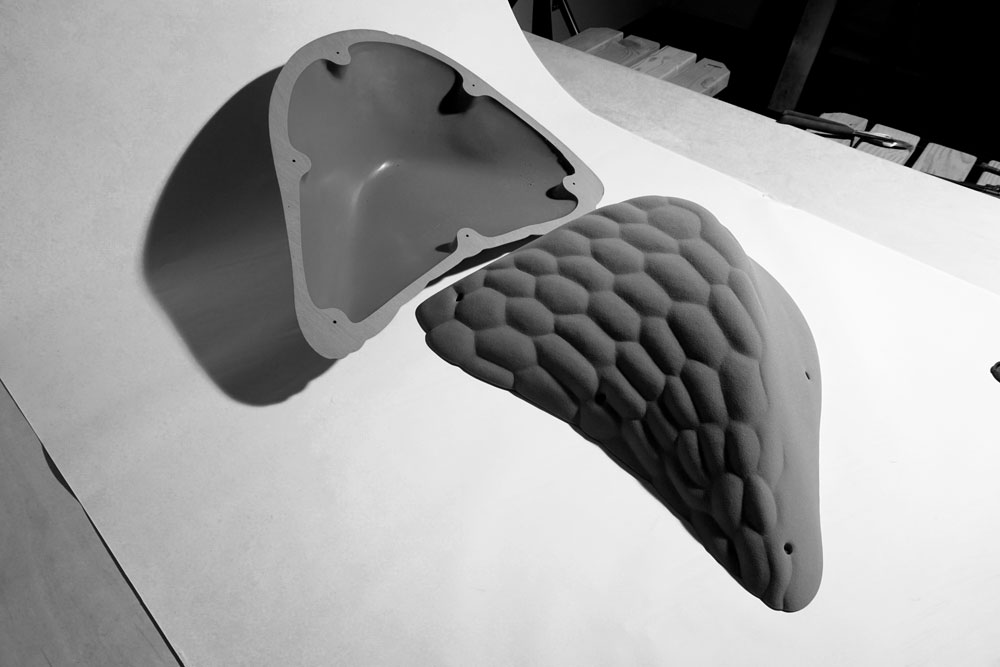
A close-up of the new Pusher Font holds.
What do you see as the biggest challenges with relaunching Pusher?
Pusher: Keeping up with it all. I seriously have people from all over the world calling me and wanting holds already. Right now I have some new shapes I made. I shaped, molded, hollow-backed, poured, sanded, and packed them myself. I just want to make sure that every Pusher hold that goes out reflects the high-quality standards that I have for Pusher. Obviously, I won’t always be able to do it all, so I just need to surround myself with people that care as much as I do. That is the Pusher way. That is what made Pusher so great in the first place. It was the people who made it happen.
You’re based in SLC. Are you planning on keeping the company headquarters and production in the area?
Pusher: Yep. Pusher is Salt Lake. When done right. it's a company that is the Salt Lake climbing scene. It always has been and always will be. If it isn’t, then it’s just not Pusher. I was born in Salt Lake and so was Pusher. I love traveling and I want people all over the world to love Pusher too, but Salt Lake will always be home.
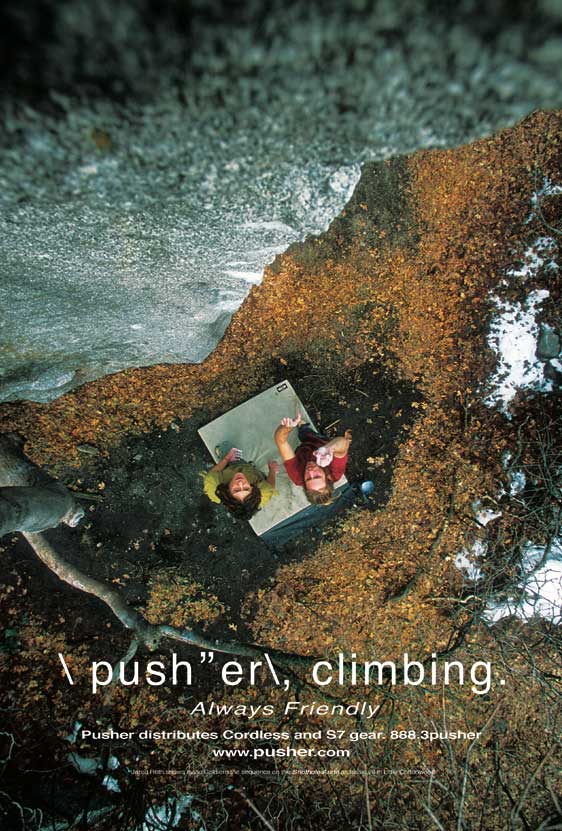
Jared Roth and Issac Caldiero (pre-American Ninja Warrior fame). (Photo: Boone Speed)
Are you planning on producing many of the classic original holds (the Boss, Jabba, Tri-Cobble) and training products (System Tiles)? Heck, I still have and use an old Tolerance Board!
Pusher: I am planning on bringing back as many of the old Classic holds as possible. The Boss is the most famous hold that has ever been made. They are all coming back. And I am going to personally re-hollow-back and mold all of them. If for some reason a shape’s master is not in the best condition I have considered reshaping them also. This would obviously take a lot of time but it’s important to me. I also want to expand on all of the old lines. Today's big gyms expect to have a line of a hundred holds or more in each style. So once I get through restoring the classics, I want to add to each line. And obviously, I want to bring in some completely new stuff. The old holds are sweet, but they are just the foundation for where I am going to take it.
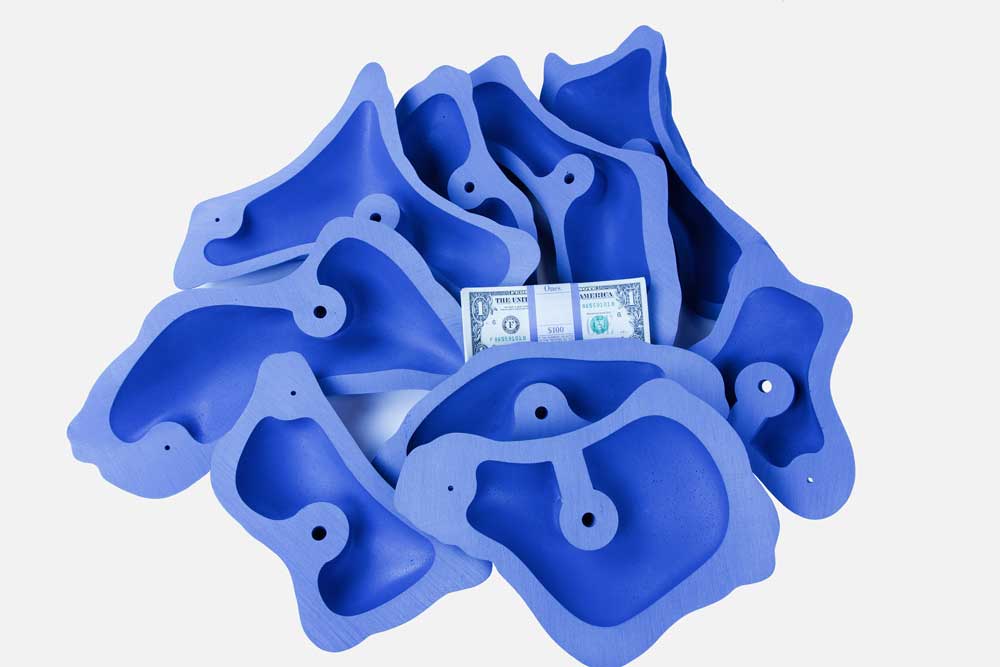
A view of the clean hollow-back finish on the new Pusher holds.
What’s the best way for folks to currently buy Pusher products?
Pusher: There is no best way. I am currently the shop manager at the Vertical Solutions hold division, and you can buy my new Font holds on our habitclimbing.com website. And for all the route setters out there, I just want to let you know that I have been working with a chemist on perfecting some new plastic that is very chip resistant. I'm also working very hard on making the hold-texture last as long as possible. I know what happens to holds in the gym these days. I don’t want to sell you a piece of crap. I will always be honest with you about the plastic and how I expect it to perform. I also want to thank the setters at The Front and the Momentum gyms in Salt Lake for testing and providing feedback on the plastic and holds.
I am working on a new Pusher site and I will let everyone know when holds are available. I might keep the pushergear.com address but change the site completely. I'm not quite sure yet. It’s a work in progress. Climbers should be able to purchase the classic holds over the summer and into the fall. And then you'll start seeing some really cool new stuff over the winter. I have talked to some people who have made some cool Pusher shapes in the past and I think everyone is interested to see how Pusher can top what it has already done. I have some plans for some new classics. You can check us out on Facebook or follow Pusherholds on Instagram – I'll let you know what is happening.
I am working on a new Pusher site and I will let everyone know when holds are available. I might keep the pushergear.com address but change the site completely. I'm not quite sure yet. It’s a work in progress. Climbers should be able to purchase the classic holds over the summer and into the fall. And then you'll start seeing some really cool new stuff over the winter. I have talked to some people who have made some cool Pusher shapes in the past and I think everyone is interested to see how Pusher can top what it has already done. I have some plans for some new classics. You can check us out on Facebook or follow Pusherholds on Instagram – I'll let you know what is happening.
Ok, how about an easy question. What are some of your favourite Pusher holds?
Pusher: Almost all of them. That’s not an easy question! The Font stuff made me like slopers when I was a kid. Boone made some cool little crimpers that I love. Jibs. The Boss? One of the Hueco crimps, one of the sandstone crimps. There is a shallow two finger pocket that's one of my favourite pockets. Tweaks. The Pusher guys used to get off work and come down to the Wasatch Front Rock Gym and trade us one-of-a-kind Tweaks for day passes. When one of your friends gives you a hold that no one else in the world has, it’s pretty special. Especially if it’s a Pusher hold.
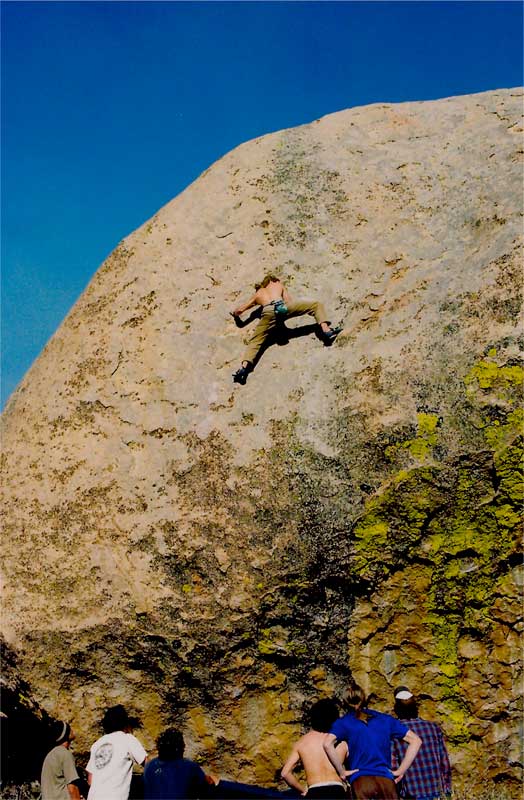
Jared Roth on the tenuous slab finish of the 65-foot tall boulder problem, Rastaman Vibration 5.14d.

